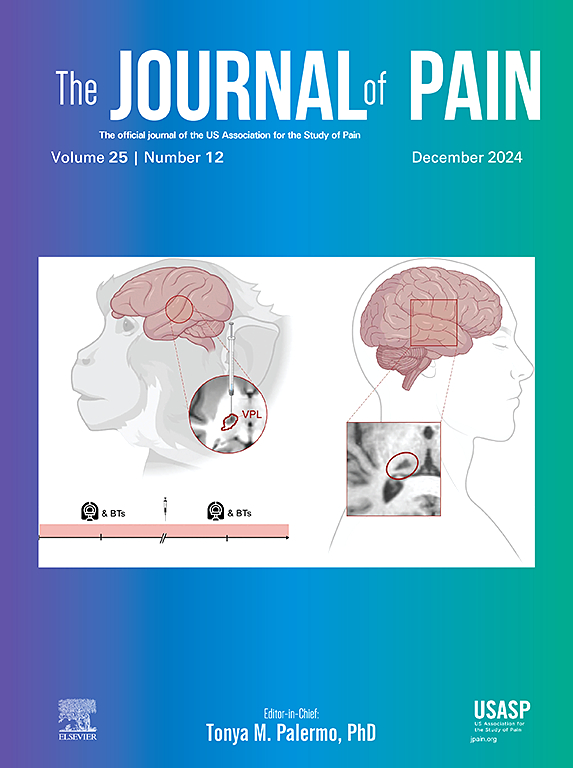腰背痛的定量感觉测试和运动诱导低镇痛方案:范围综述。
IF 4
2区 医学
Q1 CLINICAL NEUROLOGY
引用次数: 0
摘要
腰背痛(LBP)患者疼痛的一个重要驱动因素是内源性疼痛调节(EPM)的改变。EPM 可以通过定量感觉测试 (QST) 进行测量,但是,腰背痛文献中实施 QST 的方式并不一致。本范围综述旨在总结使用 QST(疼痛压力阈值 (PPT)、时间总和 (TS)、条件性疼痛调制 (CPM))或运动诱导低痛 (EIH) 评估腰背痛 EPM 的方案。2023 年 6 月 15 日,在 Medline、Embase、CINAHL 和 AMED 等数据库中检索了在枸杞痛人群中使用 QST 或 EIH 方案的文章。研究人员提取了有关参与者、研究设计、环境以及 QST 和 EIH 方案详情的数据。在纳入综述的 221 项研究中,196 项使用了 PPT,62 项使用了 TS,60 项使用了 CPM;只有 5 项研究调查了 EIH。对于所有 QST,在设备类型、时间、试验和测试地点方面存在很大差异,许多研究没有报告这些信息。在 TS 测试中使用了 4 种测试模式,在 CPM 测试中使用了 7 种不同的测试刺激和 3 种不同的调节刺激。对于 CPM 和 EIH,PPT 是最常见的测试模式。在 5 项 EIH 研究中使用了 4 种类型的练习。本范围综述总结了枸杞多糖症的 QST 和 EIH 方案,可作为未来研究的评估指南。这些结果表明有必要制定标准化方案和报告指南。观点:本文总结了用于评估枸杞多糖症中 EPM 的措施。结果显示,文献中使用的方案差异很大。未来的研究应侧重于制定标准化方案和报告指南,并为研究人员提供更多指导,帮助他们针对研究问题选择合适的测试。本文章由计算机程序翻译,如有差异,请以英文原文为准。
Quantitative sensory testing and exercise-induced hypoalgesia protocols in low back pain: A scoping review
A significant driver of pain in individuals with low back pain (LBP) is alterations to endogenous pain modulation (EPM). EPM can be measured using quantitative sensory testing (QST), however; there are inconsistencies in the way QST has been implemented across the low back pain literature. The objective of this scoping review was to summarize protocols used to assess EPM using QST (pain pressure threshold (PPT), temporal summation (TS), conditioned pain modulation (CPM)) or exercise-induced hypoalgesia (EIH) in LBP. Databases Medline, Embase, CINAHL and AMED were searched on June 15, 2023, for articles that used QST or EIH protocols in LBP populations. Data was extracted on participants, study design, setting and details on QST and EIH protocols. Of the 221 studies included in the review, 196 used PPT, 62 used TS and 60 used CPM; only 5 studies investigated EIH. For all QST, there was high variability in the type of equipment, timing, trials, and testing location with many studies not reporting this information. There were 4 testing modalities used for TS, and 7 different test stimuli, and 3 different conditioning stimuli used across the studies for CPM. For CPM and EIH, PPT was the most common testing modality. There were 4 types of exercises used across the 5 EIH studies. This scoping review provides a summary of QST and EIH protocols in LBP that may be used as a guide for assessment in future studies. These results demonstrate a need for the development of standardized protocols and reporting guidelines.
Perspective
This article presents a summary of measures used to assess EPM in LBP. The results show the wide variability of protocols used in the literature. Future research should focus on creating standardized protocols, reporting guidelines and providing more guidance for researchers in selecting appropriate tests for their research questions.
求助全文
通过发布文献求助,成功后即可免费获取论文全文。
去求助
来源期刊

Journal of Pain
医学-临床神经学
CiteScore
6.30
自引率
7.50%
发文量
441
审稿时长
42 days
期刊介绍:
The Journal of Pain publishes original articles related to all aspects of pain, including clinical and basic research, patient care, education, and health policy. Articles selected for publication in the Journal are most commonly reports of original clinical research or reports of original basic research. In addition, invited critical reviews, including meta analyses of drugs for pain management, invited commentaries on reviews, and exceptional case studies are published in the Journal. The mission of the Journal is to improve the care of patients in pain by providing a forum for clinical researchers, basic scientists, clinicians, and other health professionals to publish original research.
 求助内容:
求助内容: 应助结果提醒方式:
应助结果提醒方式:


